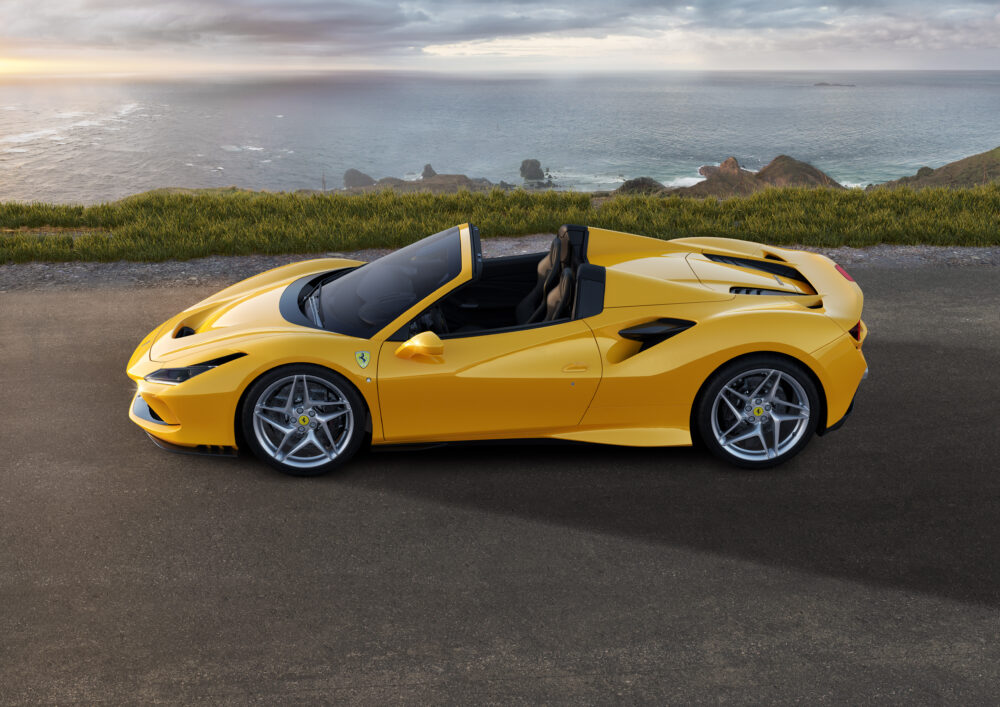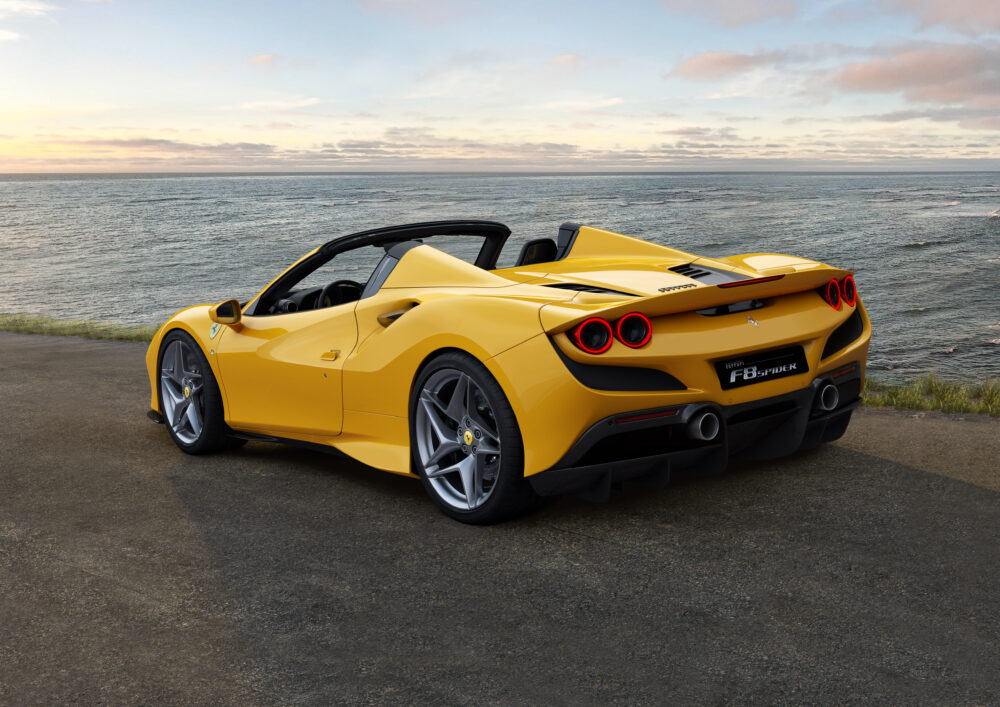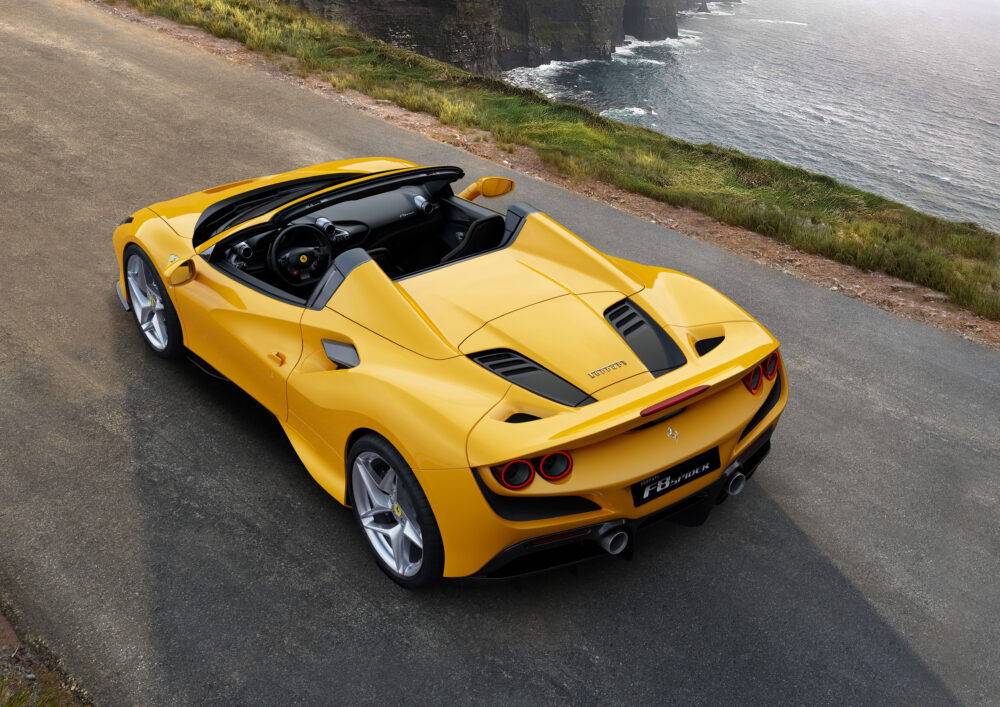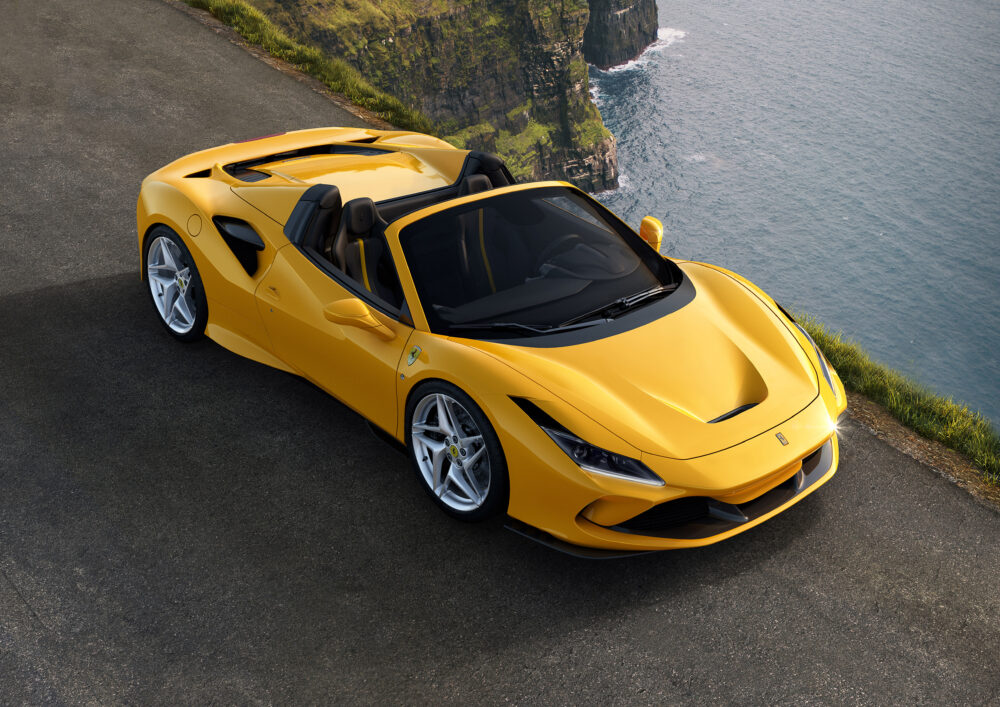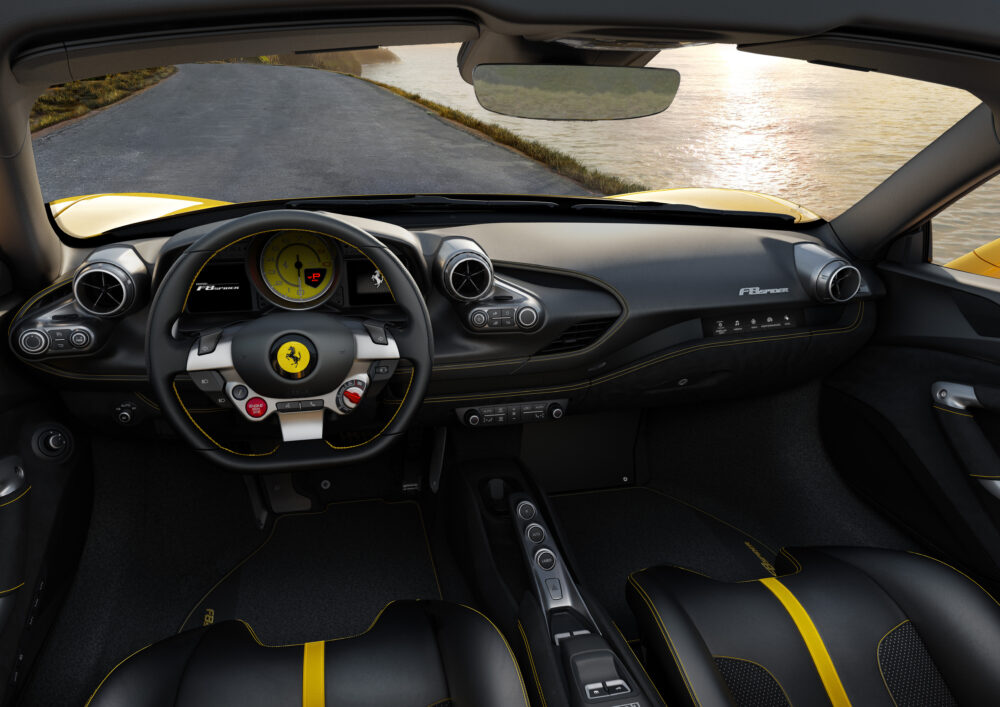Ferrari Unveils F8 Spider
F8 Spider is the latest creation of exclusive line of open V8 cars that began with 308 GTS in 1977.
Ferrari has unveiled the F8 Spider, the latest generation of sports cars equipped with the most successful central-rear V8 engine ever.
The contents of the new Ferrari take their cue from those of the F8 Tributo berlinetta even if, in reality, the Ferrari F8 Spider project is totally independent and is born in parallel, around the folding hard top RHT (Retractable Hard Top) as a key element to outline lines and characteristics of the model, which is positioned at the top of its category.
The F8 Spider is the latest creation of a prestigious and exclusive line of open V8 cars that began with the 308 GTS in 1977. It is less extreme than the 488 Pista Spider but is more sporty than the 488 Spider, which it replaces.
Consequently, it is proposed as the new benchmark of reference in the sector of super sports models “en plein air” for its very high performance, great maneuverability and truly satisfying driveability. In fact, it stands out for its exceptional driving dynamics combined with surprising comfort on board.
This Ferrari spider is capable of combining the qualities of the most awarded 8-cylinder engine of all time, which has set new limits not only for turbo engines, but for all engines of all times, driving pleasure in every situation.
It is based on the same unit that was awarded for four consecutive years (2016, 2017, 2018 and 2019) as the “International Engine of the Year,” as well as being recognized as the best engine of the last 20 years. An incredible prize for an engine, and an enterprise never succeeded in any other engine in the history of the award.
The main advantage of the F8 Spider is to deliver the 720 hp instantly, without turbo lag, and to maintain the special “soundtrack” represented by the unique sound of this V8. The achievement of these performances, combined with disarming handling, has been made possible by the integration of innovative aerodynamic solutions in the car body, derived from the experience gained in competitions.
Each new car from the Maranello company has as its mission to always introduce new design content and achieve even higher performance than in the past. The challenge for the staff of engineers and designers is to overcome themselves and their limits, moving the bar ever higher to introduce new cutting-edge solutions and set new values ​​of excellence. Also in this case, the result was brilliantly achieved.
The F8 Spider replaces the 488 Spider improving its specifications: in addition to the engine, capable of delivering 50 hp more, the new Ferrari is 20 kg lighter than the previous model. It weighs only 20 kg more than the more extreme 488 Pista Spider.
It benefits from a significant increase in aerodynamic efficiency and the new version of the Side Slip Angle Control in version 6.1.
Engine
The 8902 cm 3- cylinder engine is seen, in the automotive world, as the symbol of sportiness and driving pleasure, even more when it is mounted in a central-rear position in a two-seater car. This type of architecture makes it possible to obtain an optimal balance of weights for an unparalleled sporty and exciting behavior. Ferrari has made it a value of excellence for over 40 years.
The technical specifications of this V8 are remarkable. The F8 Spider is capable of delivering 720 hp at 8,000 rpm and with an impressive power of 185 hp / l. The maximum torque is increased at all speeds, up to 770 Nm peak at 3,250 rpm.
Today the 8-cylinder Ferrari adopts engineering solutions so refined as to be considered masterpieces, and this engine in particular exalts the characteristics of the engines of the Maranello company, with a progressive and almost inexhaustible acceleration, the total absence of turbo lag and a sound unique, obtained also thanks to a new unloading system.
The new car offers pure excitement thanks to ease of driving and immediate use of engine performance, made possible based on the use of advanced vehicle dynamics solutions. These include the extension of the Ferrari Dynamic Enhancer Plus (FDE +) control system to the RACE position of the Manettino to facilitate ease and confidence at the limit.
To get the 50-hp increase in power compared to the 488 Spider, the new intake line is a direct derivation of the 488 Challenge. In the F8 Spider, the engine air intakes are moved from the side to the rear area, to the sides of the blown spoiler where they are directly connected to the engine air inlet. In this way, it was possible to drastically reduce the load losses, increasing the air flow rate and consequently the power. The air flow also benefits from higher dynamic pressures, thanks to the shape of the rear spoiler.
The “Adaptive Performance Launch” monitors the grip conditions during acceleration and optimizes the transmitted torque with electronic controls, depending on the grip of the road surface, minimizing wheel slip and thus maximizing acceleration.
The “Wall Effect” strategy on the rev limiter, represents another step towards the extreme performance of the engine. The new strategy leads the engine to reach the maximum speed no longer with a gradual control of the limiter, but cutting it on the threshold of 8,000 rpm, maximizing the availability of the power in strongly dynamic use and consequently improving the lap time.
The strategy of the Variable Torque Management based on the gears is also confirmed for this model. To adapt to the sporting spirit of the car, all the gears reach the maximum torque at high revs, for a continuous stretching sensation up to the red zone of the tachometer. The maximum torque increases compared to the 488 Spider by + 10 Nm and is available from the first rotation speeds.
The engine of the F8 Spider inherits from the 488 Pista effective lightening solutions, which allow to reduce the engine weight by -18 kg compared to the 488 Spider. The weight reduction of the rotating and non-static masses such as the titanium connecting rods, the crankshaft and the flywheel, allows the engine to rev up more rapidly, so that the pilot can realize this by looking at the speed of the tachometer needle, especially in the gearboxes and in low-speed burning accelerations. The reduction in the weight of the rotating masses allows a reduction in inertia of 17%.
Inconel exhaust manifolds derived from the 488 Challenge contribute to a 9.7 kg reduction in engine weight. The layout of the exhaust was also entirely modified starting from the air outlet of the turbines up to the terminals, with the aim of defining a unique and dedicated sound for this car. The result is an engine with an unmistakable tone, improved both in terms of intensity and sound quality.
The exhaust line is completed by the particulate filter (GPF), in compliance with the new homologation regulations.
Design
Designed by the Ferrari Style Center, the F8 Spider continues that approach begun with the F8 Tributo, which tends to represent a new design language, always strongly oriented towards sportsmanship and functional to aerodynamic performance.
In the design phase of a spider, the choice of roof type is the fundamental element of design. Ferrari has chosen for some years to use a rigid cover for the benefit of comfort. Just around the RHT (Retractable Hard Top) folding hard top was the common thread that defined the lines of the F8 Spider.
The keystone of the project was to move the separation line between the car body and the roof from the belt point at the occupants shoulder, as normally happens, to above the upright. In this way the roof becomes an object of limited thickness and predominantly two-dimensional development, which can be divided into two parts to be housed above the front of the engine.
The roof takes only 14 seconds to lower or rise and the opening and closing can also be done with the car moving, up to a speed of 45 km/h.
Exterior
The goal set at the Ferrari Style Center for the F8 Spider, was to draw a stylistic tribute to the Ferrari V8 engine, evolving the contents of the F8 Tribute in an open key and drawing inspiration from the most iconic uncovered mid-rear engine models ever, significantly distinguishing the car with a more sporty and functional aerodynamic style.
The front view of the car is strongly characterized by the introduction of the S-Duct. Around this solution, all the elements have been redesigned to highlight the main aerodynamic functions. The most obvious example is the new LED headlight, with smaller shapes and developed entirely horizontally.
The bigger spoiler has been completely redesigned; it wraps the rear lights, visually lowering the center of gravity of the car and also allowing the return to the classic double headlight set in the housing of the same body color, recalling the design of the first 8-cylinder Berlinette as the 308 GTB.
The bonnet treatment is one of the distinctive features of the F8 Spider.
The “MANTA” theme (T theme) of the F8 Spider’s rear bonnet is characterized by a central back that starts from the rear window and slides to disappear under the wing of the blown spoiler, supporting the movement of air flows.
The two wings that come from the central volume harmoniously connect to the car body, giving a sense of continuity in all views.
At the same time these elements remain suspended creating an underlying air vent that facilitates greater dissipation of heat from the engine. In this sense, the three slits carved on the side elements that complete the bonnet also work, thus evoking the iconic style of the coupé rear window.
The same elements treated in black contribute to the containment of the total weight and guarantee a visual clarity of the design.
The ridges that start from the prominent volumes of the tonneau fins flow sinuously towards the rear and engage the spoiler. Almost an interpretation of the “gooseneck” supports of Formula 1 cars, giving the car a strong sporting connotation.
Interior
The interior of the F8 Spider maintains the classic “cockpit” style theme, characteristic of the 8-cylinder mid-rear engine. A concept that sees the perfect symbiosis between driver and passenger compartment, as in F1, with the positioning of all the controls on the new generation steering wheel. The sports seats are also new.
The dashboard is embellished with an aluminum sail that supports the central satellite and continues inside the bridge itself. Always with a view to lightening, a carbon fiber grain divides the upper part from the lower part, slimming the entire dashboard body. This vein also houses the optional 7-inch touchscreen passenger display and the dashboard is completed by the classic instrument panel with central rev counter.
The tunnel is well separated from the dashboard and falls below it always to amplify the car’s feeling of lightness. The new bridge is installed on the tunnel, a prominent and optically floating sculpture, which further streamlines the car’s interior.
Aerodynamics
The F8 Spider integrates the state of the art, in terms of aerodynamic solutions, innovations and Ferrari know-how, acquired also thanks to the commitment in the GT and Challenge championships, and perfects it to create the standard mid-engine rear discovery with the highest level of performance accessible to all types of drivers.
In the F8 Spider, the positioning of the front radiators, with an inverted inclination compared to the 488 Spider, represents a benefit in terms of cooling but at the same time reduces the useful surfaces on the bottom for load generation. For this reason it was necessary to redesign the geometry of the ducts for the dissipation of hot air, in order to still generate the maximum load level and at the same time obtain a decrease in resistance due to the positive interaction of the flows exiting the radiator with the wheel front. The result is an improvement in the overall efficiency of the car by 10% compared to the 488 Spider.
Vehicle DynamicsÂ
Absolute performance is significantly higher than the 488 Spider, thanks to the increase in power, weight reduction and improved aerodynamic coefficient. They are made available to a wider number of drivers thanks to vehicle dynamics that favor ease and confidence of driving at the limit, such as the steering wheel with reduced diameter crown and the new Ferrari Dynamic Enhancer Plus actuation system, which is integrates into the SSC concept, now in version 6.1.
To achieve the goal of usability of performance, Ferrari engineers have worked on integrating engine and aerodynamics performance with the latest evolution of control systems. The Side Slip Control, which improves the pilot’s ability to manage driving to the limit making the experience more enjoyable, is present in this car in the 6.1 version. The transition from version 6.0 to 6.1 is linked to the extension of the Ferrari Dynamic Enhancer control system to the Race position (FDE +).
The FDE is the lateral dynamic control that uses a control channel connected to the hydraulic pressure of the braking system. He made his debut on the Ferrari 488 Pista and was then adopted on the 488 Pista Spider. In the FDE + version, it is extended in terms of functionality first on the F8 Tribute and now on the F8 Spider. The control system, already operating in conditions of travel and exit curve (but not under braking), also acts in conditions of low grip and with the Manettino in the Race position.
Photos: Ferrari


